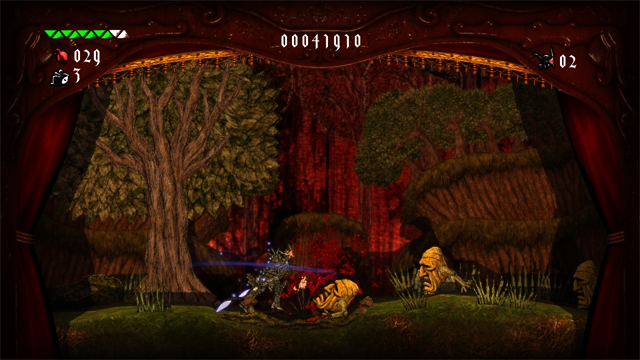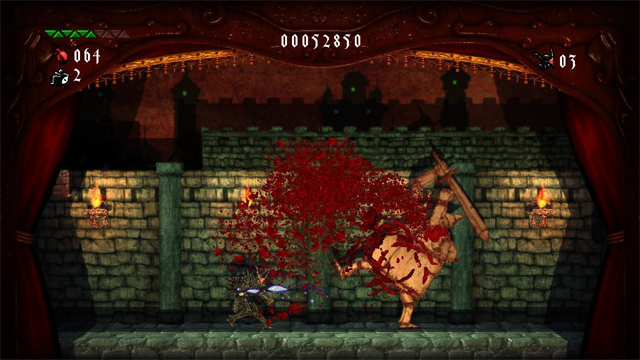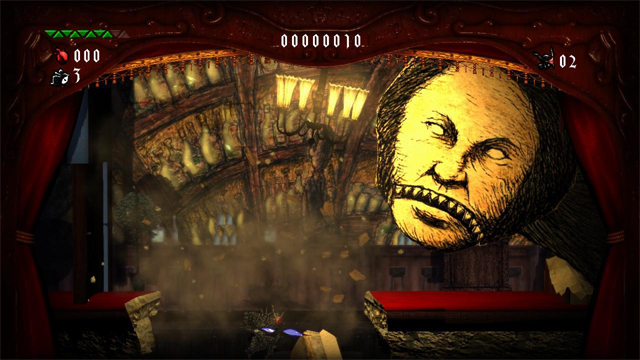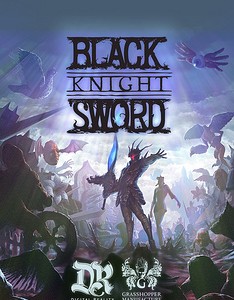Retro games have experienced a resurgence during the modern era of digital content delivery and consumer accessibility. Ease of development, nostalgic marketability, lightweight mobile platforms, and publisher cash-in opportunities all seem to play some part in this trend. It can often be discouraging to wade through what feels like a children’s ball pit of rehashed ideas and unimpressive sameplay that suggest a lack of care for the medium, but projects like Grasshopper Manufacture and Digital Reality’s Black Knight Sword reassure gamers that an appreciation of classic style remains, and that developers still have a desire to fine tune, for the modern era, what ignited our excitement for video games years ago.
 Black Knight Sword begins with a simple side-scrolling, action-platformer model, in which players take control of the titular Black Knight and rush off on a quest to kill the the princess. Kill the princess: With those words, one already begins to understand that Black Knight Sword has been designed with veteran gamers in mind, and has something to say about the industry that they have grown up with. Black Knight Sword takes the universally recognized theme that first defined the 8-bit generation in Super Mario Bros. and turns it immediately on its head, as if to tell us that simply “going retro” isn’t enough to get gamers’ nostalgic neurons firing.
Black Knight Sword begins with a simple side-scrolling, action-platformer model, in which players take control of the titular Black Knight and rush off on a quest to kill the the princess. Kill the princess: With those words, one already begins to understand that Black Knight Sword has been designed with veteran gamers in mind, and has something to say about the industry that they have grown up with. Black Knight Sword takes the universally recognized theme that first defined the 8-bit generation in Super Mario Bros. and turns it immediately on its head, as if to tell us that simply “going retro” isn’t enough to get gamers’ nostalgic neurons firing.
The trappings of those pre-3D games pervade Black Knight Sword, and that “retro” feeling is evident upon picking up the game pad. Controls are precise in some ways (swordplay), while unpredictable in others (jumping, dodging, aiming), and mastery of the game’s expression of avatar actions is a skill to be rewarded, while failure is punished. The balance of cruelty and encouragement leans just enough toward harsh difficulty to keep players fearful of their demise, keen and aware to perform their best as they progress through each of five sparsely checkpointed, linear stages, in which enemies inconsistently respawn and some jumps can only be completed at ledges’ pixel-splitting extremities.
 The familiar framework, however, is dressed up in the dark and bizarre. Morbid imagery is presented in a colorful paper cutout style within a puppet theater setting. Characters animate as if pegged at the joints and manipulated by wires, backgrounds lift up, slide into place, and fall away like the work of telekinetic stage hands, and all the while an ornate red curtain frames the stage (screen) on which the Black Knight’s tale unfolds. Between those charming curtains, though, the knight collects human hearts as currency, restores his health using skulls found inside microwaves, and slices deformed monstrosities bent on killing him until they explode spectacularly in fountains of blood, all to fittingly diverse and textured sound effects, as well as Akira Yamaoka’s synth-industrial score, which shows up in varying degrees of complexity throughout the game.
The familiar framework, however, is dressed up in the dark and bizarre. Morbid imagery is presented in a colorful paper cutout style within a puppet theater setting. Characters animate as if pegged at the joints and manipulated by wires, backgrounds lift up, slide into place, and fall away like the work of telekinetic stage hands, and all the while an ornate red curtain frames the stage (screen) on which the Black Knight’s tale unfolds. Between those charming curtains, though, the knight collects human hearts as currency, restores his health using skulls found inside microwaves, and slices deformed monstrosities bent on killing him until they explode spectacularly in fountains of blood, all to fittingly diverse and textured sound effects, as well as Akira Yamaoka’s synth-industrial score, which shows up in varying degrees of complexity throughout the game.
One particularly memorable adversary is the winged humanoid creature with a bloody stump for a neck and two different birds’ heads for hands, each of which breathes fireballs. Another is the disembodied head that takes up half the screen and spews orbs AND smaller heads that then fire their own shots at the knight as he flies on the back of a giant chicken through a level that begins like Zombie Nation on the NES and ends like Grasshopper and Digital Reality’s recent bullet hell shooter, Sine Mora. Then there’s the giant gas-mask-wearing spider with human head for an abdomen….
 In contrast to No More Heroes — a game that drips 8-bit sensibilities from every crack in its broken, polygon-era game design — Black Knight Sword‘s opposite approach — applying modern styling to retro design (there’s even a taste of Grasshopper’s 2011 release, Shadows of the Damned, replicated in the game’s upgrade system) — succeeds far more admirably in bridging the gap between retro and modern, classic and avant garde, childlike and adult…delightful and deranged. Even the game’s grim fairy-tale narration tells a story of antithesis between twin princesses and the perpetual war between them: A metaphor for the evolution of game design? Holding on versus branching out? Cashing in versus crafting with care? Perhaps.
In contrast to No More Heroes — a game that drips 8-bit sensibilities from every crack in its broken, polygon-era game design — Black Knight Sword‘s opposite approach — applying modern styling to retro design (there’s even a taste of Grasshopper’s 2011 release, Shadows of the Damned, replicated in the game’s upgrade system) — succeeds far more admirably in bridging the gap between retro and modern, classic and avant garde, childlike and adult…delightful and deranged. Even the game’s grim fairy-tale narration tells a story of antithesis between twin princesses and the perpetual war between them: A metaphor for the evolution of game design? Holding on versus branching out? Cashing in versus crafting with care? Perhaps.
What’s most notable about Black Knight Sword, though, aside from the fact that it’s “weird,” is that it pays homage to the games of yesteryear without marginalizing the efforts of those who laid that groundwork, and it respectfully aims to expand upon jumping and slashing while maintaining the integrity of the genre. It’s short and difficult, it repeats bosses at the end (Gamer Pet Peeve Alert!), and it’s not the most finely tuned action platformer out there, but it ignites that nostalgic joy of childhood in an original and interesting way. That, and it says things about games — a Grasshopper standard. The real icing, though, is that this time it says those things within the context of a game that doesn’t play like a cinder block.



















This game really reminds me, at least the esthetics, of the 2D shooting stages of Shadows of the Damned.
@vdh360
Great review! I’m interested. There’s enough unique and enough familiar about this game that it may sit in a nostalgia sweet-spot.